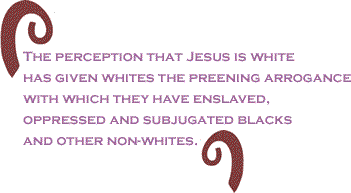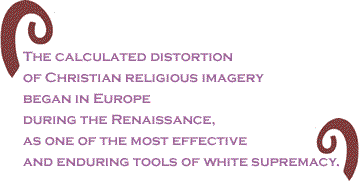
|
|||||||||||||||||||||
|
Seldom has there
been more controversy and cautious anticipation preceding the
release of a motion picture than that which has been swirling
around the film, The Passion of the Christ. The uproar
concerns its alleged depiction of the Jews of that time as
being principally responsible for sentencing Jesus to His
tortuous death and the extent to which that interpretation
may or may
not coincide with Gospel accounts. There is also some degree
of unease with what has been described as the unsparingly
graphic brutality of Jesus’ crucifixion. Still, millions of Christians,
particularly evangelicals and fundamentalists, eagerly awaited
the movie’s Ash Wednesday release and view its production as
a sign that Hollywood, long regarded as dismissive of or hostile
to Christianity, no longer ignores them. The problem I have
with this film, and the very reason that I will not see it,
is its casting. This film is just the latest example of the
one thing – with regard to virtually all dramatizations, representations
and depictions of Jesus – that is almost never questioned:
that is, that Jesus was white.
Many black people become highly agitated and offended when confronted with the issue of how and why Jesus is nearly always depicted and portrayed as a blond-haired, blue-eyed white man. Even when confronted with evidence that the people of the Holy Land at that time almost certainly didn‘t look like that, Black ministers will sometimes harshly admonish their congregants for even entertaining such thoughts. Many black clergymen (and women), most of whom of course have a picture of this Caucasian Messiah hanging behind their pulpits, have even been known to respond to the issue with a reminder that despite what Mary and Joseph may have looked like, Jesus was, after all, God’s son; seemingly oblivious to the inference this makes. True believers, they say, should cultivate a spiritual relationship with Jesus and be endlessly grateful that He came to deliver and redeem us from sin, to be our comforter through the storms of life and to intercede on our behalf to God and not concern themselves with a matter as trivial as what Jesus looked like. To follow this pious decree, however, is to turn a blind eye to the calculated distortion of Christian religious imagery, which began in Europe during the Renaissance, as one of the most effective and enduring tools of white supremacy. This is the principal basis upon which Christianity was introduced to Africans in this country. As the African-American theologian James Cone has noted:
While from a spiritual standpoint it is vital to keep in mind
Jesus’ message of love and forgiveness, it is also willfully
naďve to accept that the persistent Euro-centric representations
of Him are mere coincidence.  The fact is that white people desperately want to believe
that Jesus was white. Why? Because it is sine qua non (‘without
which it is not’) to the political and social doctrine of
white supremacy, the belief that whites are innately superior
to and possess the right of hegemony over dark-skinned people.
Without the belief that God and therefore Jesus were (are)
white, they cannot lay claim to having been made in His image
and thereby justify the racial hierarchy that they have created
upon which they claim the top spot.
Do we have any way of knowing what “color” Jesus actually
was? The Bible contains no specific physical descriptions
of Jesus. There are some compelling pieces of evidence, though
admittedly indirect, that indicate Jesus almost certainly
was a person of color. According to the African-American
biblical scholar Cain Hope Felder, we should view the Middle
East of Jesus' day as a kind of eastern extension of Africa.
According to available archaeological and linguistic evidence,
the interaction of peoples between those regions can readily
be established. We know that the entire Jewish nation, including
all members of Jesus’ genealogical lineage, lived in Egypt
for many years before Moses led them out. Jesus Himself is
known to have lived in Egypt for a time when his earthly
father Joseph was visited by an angel and told to flee there
with the Christ child from Herod the king, who intended to
kill Him. (Matt. 2: 13) (Why would they have been sent to
hide in a place where they couldn’t have blended in with
the local population?) God Himself heralds His return with
the words, “Out of Egypt did I call my son.” (Matt. 2: 15) One of the main selling points of the "The Passion of
the Christ" is its unprecedented realism, the most prominent
example being its dialogue consisting only of the Aramaic,
Latin and Hebrew languages spoken during biblical times.
But if the film’s producer Mel Gibson was aiming for such
a high degree of cinematic verite, why didn’t he use actors
who looked like the people of that time? Of course that is
a rhetorical question that we all know the answer to; Jesus
was white, end of discussion. Mel Gibson has used his claims
of difficulty in getting this picture made to add a crusade-like
aura to its release, which coming from an A-List Hollywood
superstar such as he I find very hard to believe. Difficulty
of an insurmountable nature would certainly have arisen had
he attempted to film a movie about Jesus casting Omar Epps
and Alfre Woodard as Mary, and we know why. It’s probably no coincidence that a network television news
report the night before the nation-wide release of the film
featured comments by several African-Americans as they exited
a movie theater after seeing the film. One gentleman had
spent thousands of dollars of his own money to screen the
film in advance of its release; one lady was shown kneeling
on the ground outside of the theater crying "Thank you,
Jesus! Thank you, Lord!" There is no doubt that many
people will be awed, moved and touched by seeing The Passion
of The Christ. But all should bear in mind that the fact
that the subject of the film is divine does not in any way
confer divinity upon the film itself. And whether or not
we choose to acknowledge it, this movie reflects two deeply
held “Passions”: the one that unfolds on the screen and the
deviously scheming one that lurks beneath it. |
March
11
2004 |
|||||||||
|
|||||||||
|
|
|||||||||
| Printer Friendly Version | |||||||||
 |
|||||||||
| |
|||||||||
| |
|||||||||



























